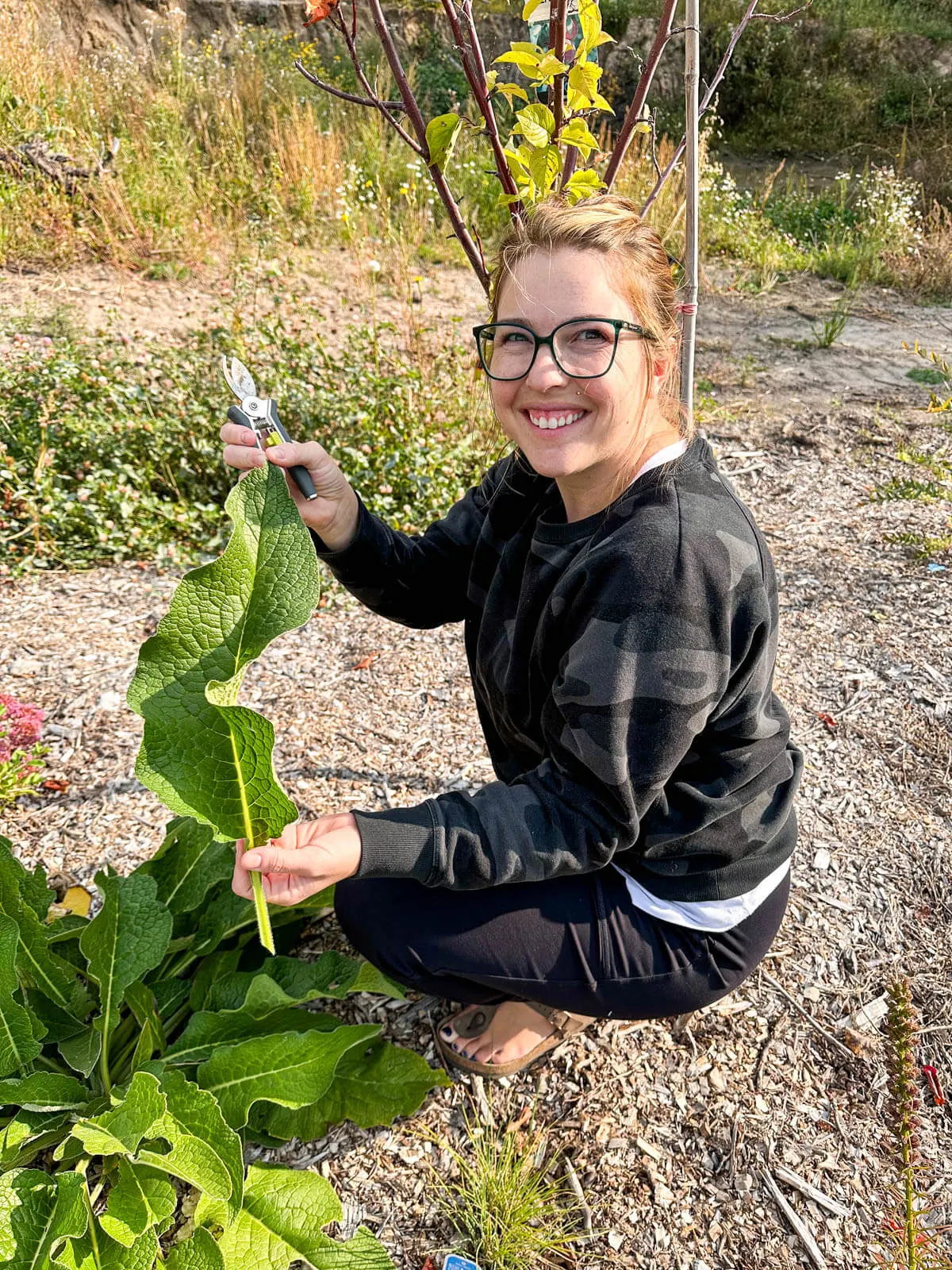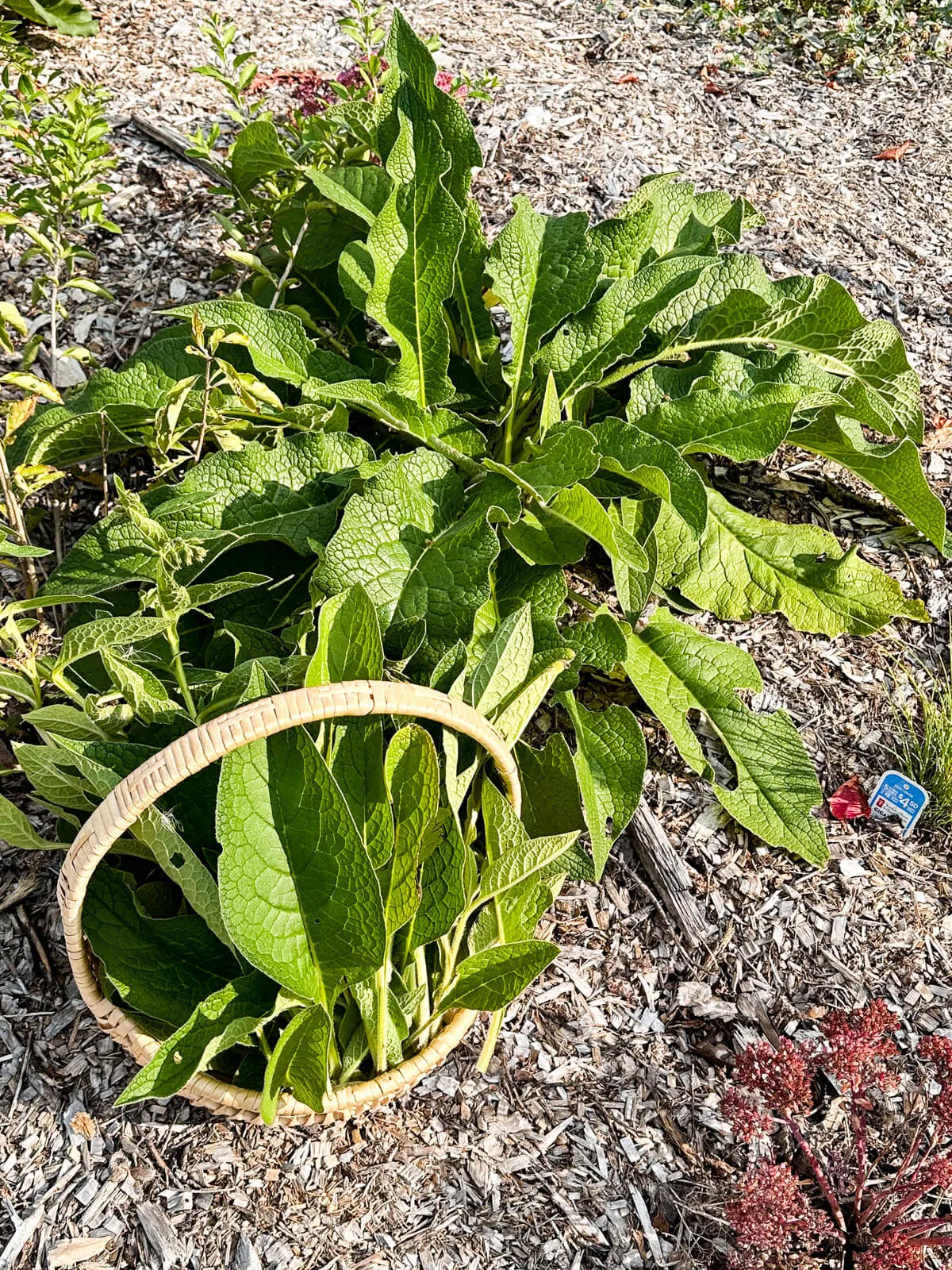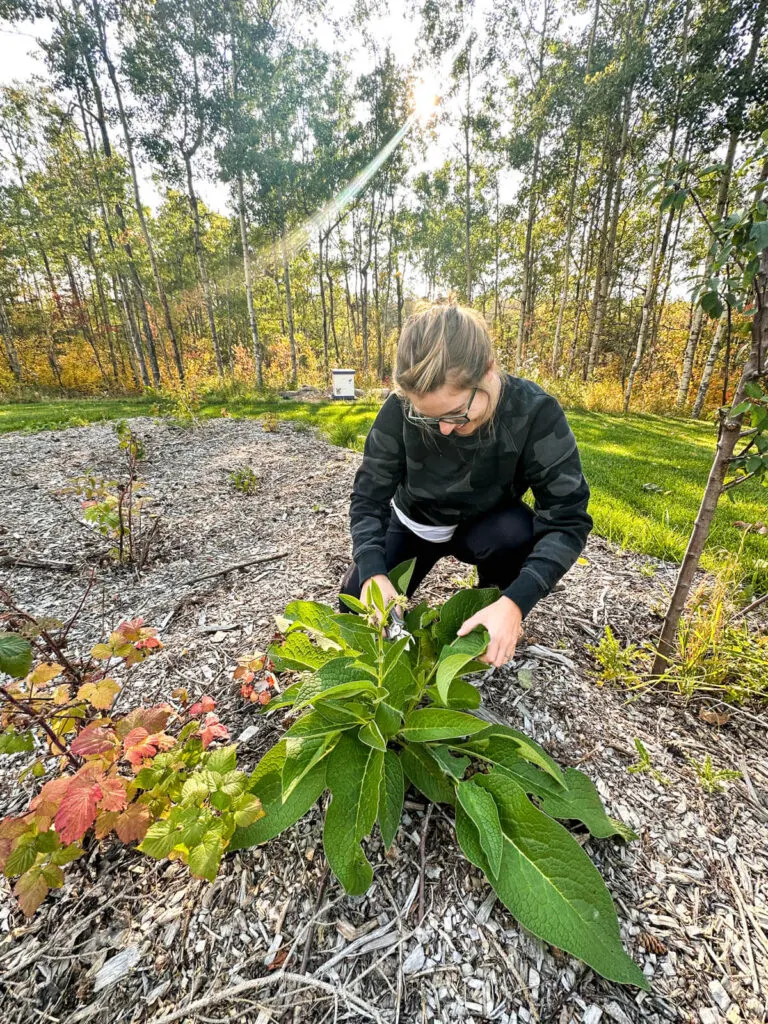Comfrey seems to be the quintessential permaculture plant. Any time someone says they practice permaculture, you just know they're about to tell you about their comfrey plants!
Up until spring 2023, Kevy and I were missing the comfrey badge for our food forests. Thankfully, we made some great permaculture friends along the way and a couple of them showed up to the homestead this spring with comfrey root cuttings saying "We think you need these."
At long last, we were part of the cool comfrey club and this fall we were able to harvest leaves from this amazing plant for the FIRST time!

As an Amazon Associate I earn from qualifying purchases.
Jump to:
What Is Comfrey?
Comfrey (Symphytum spp.) is a cold hardy perennial herb native to Europe and parts of Asia. It's been introduced in North America as an ornamental. It's known for its beautiful bell-shaped flowers that can range in color from cream, pink, and blue to purplish-blue, depending on the variety.
The plant typically grows between 2 to 5 feet tall, and it has hairy and angular stems. The leaves are large and broad at the base, getting smaller as they go up the stem. They are usually dark green on the top and lighter underneath, with a rough, hairy texture.
Comfrey is also recognized for its thick, black, root. This root system is vigorous and allows the plant to thrive in a wide range of soil types, although it prefers rich, moist soil.
One of the most notable characteristics of comfrey is its use in herbal medicine. The plant has been used in traditional medicine for centuries, particularly for its ability to heal wounds and broken bones. However, it's important to note that oral consumption is generally not recommended due to the presence of certain toxic compounds that can affect the liver over time.
Comfrey is also often used in organic gardening and permaculture practices as it is believed to be a dynamic accumulator. Its leaves are a rich source of nutrients and can be used to make an excellent fertilizer and additions to the compost pile.
Many people practice chop and drop mulching which is a lot like comfrey compost, allowing the leaves to decompose in place around the plants in their food forests and forest gardens to return the nutrients to the surface level for use by microbes in the soil. While others use the large leaves to make comfrey tea fertilizers to feed plants liquid nutrients.

Tips + Tricks
No. 1 --> No matter the herbal benefits of comfrey, it should NOT be ingested. It contains pyrrolizidine alkaloids which can cause liver toxicity and that is the absolute opposite of what we want as people who turn to natural healing. Use caution and research before using comfrey in your own home.
No. 2 --> Comfrey plants are covered in tiny little hairs that your skin may find irritating, so a thin pair of gardening gloves may be beneficial.
No. 3 --> Allowing comfrey to flower can reduce the leaf biomass available for harvest, so if leaves are your main goal when it comes to comfrey, it's a good idea to snip flower stalks as they appear. BUT... like borage, comfrey's flowers are very attractive to local pollinators, so we like to let ours flower for our homestead honey bees.
No. 4 --> Growing comfrey is very easy, and if you're looking to acquire plants, simply put the word out in your community - it seems comfrey lovers are always willing to share crown cuttings. Comfrey can be a bit invasive, so ask if the plants are a Bocking variety - as those plants will flower but not produce viable seed, but they will reproduce via root cuttings.

Harvesting Guidelines
How you harvest comfrey depends on the age of your plants. Regardless of the age of the plants, they should be harvested in early - mid September, before the first hard frost 28F or -3C.
New Comfrey Plants
If you have freshly planted, first season comfrey, you're only going to get one harvest from the plants during the first year.
Ideally, during the growing season, you'll allow the plant to grow and pump tons of nutrients via photosynthesis into the tap root for as long as possible. Trimming flowering stalks as they appear can also help the plant put more energy into establishing, but it is not a requirement.
Established Comfrey Plants
Healthy established plants, 2 years and older, usually offer at least 2 harvests per season! Usually in July and September.
When harvesting comfrey leaves from existing plants, aim to chop the leaves when the plant reaches about 2 feet tall.

How To Harvest Comfrey Leaves
Harvesting for herbal purposes:
- Use a pair of garden snips to give a clean cut to the leaf petiole (leaf stalk) near the base of the plant. Flowering stalks can also be harvested.
- Leave smaller, still-furled leaves on the plant, even if it's the last season of the harvest. These leaves will continue to grow and capture energy for the plant beyond the first killing frost.
- From here, you can use it as desired.
Harvesting for chop and drop:
- Grasp the leaves into a bunch and slice them near the base of the plant with a sharp tool, we like our hori hori knife for this kind of harvesting.
- Spread the leaves on the surface anywhere you'd like to add extra nutrients to the soil.


Notes From The Homestead Garden
Comfrey is indeed a permaculture superstar, but don't discount its worth in your medicinal herb garden.
Its deep tap root and powerful nutrient-accumulating capabilities, adaptability to various soil types, and its use in traditional medicine make it an invaluable addition to your landscape. While its cultivation requires mindful practices due to its potential invasiveness and toxicity if ingested, the benefits of planting comfrey in your cottage garden far outweigh the downsides.
From enhancing soil fertility to attracting pollinators, comfrey proves to be more than just a plant—it's a tool for sustainable gardening and a testament to the beauty and strength of nature. Whether you're a seasoned gardener or a beginner, consider joining the 'comfrey club' and experience the magic of this plant firsthand.
Pin This Guide To Harvesting Comfrey Leaves

